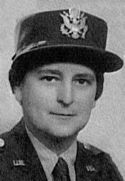- Mercedes O. Cubria
-
Mercedes O. Cubria
Lt. Col. Mercedes O. Cubria
The first Cuban-born female officer in the U.S ArmyNickname "Tia" Born 1903
Guantanamo, CubaDied 1980
Miami, FloridaAllegiance United States Service/branch  Women's Army Corps (WAC's)
Women's Army Corps (WAC's)
United States ArmyYears of service 1943-1973 Rank 
Lieutenant ColonelBattles/wars World War II
Korean WarAwards Legion of Merit (2x), Bronze Star Medal Lieutenant Colonel Mercedes O. Cubria (1903-1980), a.k.a. La Tia (The Aunt), was the first Cuban-born female officer in the U.S. Army. She served in the Women's Army Corps during World War II, in the U.S. Army during the Korean War, and was recalled into service during the Cuban Missile Crisis. In 1988, she was posthumously inducted into the Military Intelligence Hall of Fame.
Contents
Early years
Cubria was born in Guantanamo, Cuba in 1903. While she was still a young girl, her family moved to the United States. After completing her primary and secondary education, she worked as a nurse and rancher in the years leading up to World War II.[1][2]
Military service
On July 3, 1943 the WAC bill established the Women’s Army Corps as an integral part of United States Military. The bill was signed into law (Public Law 78-110), and became effective on September 1, 1943. Cubria enlisted in the Women's Army Corps after the U.S. entered World War II and, after her basic military training, she was sent to England for further training in cryptography. Cubria was commissioned with the rank of Lieutenant, making her the first Cuban-born female officer in the United States Military. [1] She was assigned to the 385th Signal Company. She was later reassigned to the 322nd Signal Company, where she worked on secret codes, and on gathering information on the Axis Powers.[1][2][3]
When the WAC bill established the Women’s Army Corps in 1943, Cubria and her female comrades-in-arms became members of the regular Army.[4]
After World War II ended, Cubria was promoted to the rank of Captain. She was assigned to the U.S. Army's Caribbean Theater, based at Quarry Heights in the Panama Canal Zone; she was the first woman to serve in active duty in that theater. [2]
When the United States entered the Korean War, Cubria was promoted to Major and deployed to Japan, where she continued to work in military intelligence. When the Korean War ended in 1953 Cubria was given a medical discharge, and was awarded the Bronze Star Medal for "meritorious achievement in ground operations against the enemy".[1][2]
In 1962, Cubria was recalled to service by the U.S. Army as a result of the Cuban Missile Crisis. She worked primarily in the role of de-briefing Cuban refugees, as well as defectors who were fleeing the Cuban communist regime.[2] She also helped the refugees find jobs and places to live. Cubria's work with the refugees proved to be a significant asset to the United States Army and the Central Intelligence Agency. Cubria was awarded the Legion of Merit and continued to serve for the next eleven years.[1]
Legacy
Cubria was promoted to Lieutenant Colonel and in 1973, at the age of 70, retired once more from the military. She was awarded a second Legion of Merit upon her retirement. Mercedes Cubria died in 1980 in her home in Miami, Florida.[1][2]
In 1988, Cubria was posthumously inducted into the Military Intelligence Hall of Fame.[5] The Military Intelligence Hall of Fame is a Hall of Fame established by the Military Intelligence Corps of the United States Army in 1988, to honor soldiers and civilians who have made exceptional contributions to Military Intelligence. The Hall is administered by the United States Army Intelligence Center at Fort Huachuca, Arizona.[6]
Awards and decorations
Among Lt. Col. Cubria's military decorations were the following:[3]
 Legion of Merit w/ bronze service star device
Legion of Merit w/ bronze service star device Bronze Star
Bronze Star Army Good Conduct Medal
Army Good Conduct Medal Women's Army Corps Service Medal
Women's Army Corps Service Medal American Campaign Medal
American Campaign Medal European-African Middle Eastern Campaign Medal
European-African Middle Eastern Campaign Medal World War II Victory Medal
World War II Victory Medal National Defense Service Medal
National Defense Service Medal Korean Service Medal
Korean Service Medal Army Service Ribbon
Army Service Ribbon Army Overseas Service Ribbon
Army Overseas Service Ribbon
Further reading
- The Book Of Latina Women: 150 Vidas of Passion, Strength, and Success; by Sylvia Mendoza; Publisher: Adams Media Corporation; ISBN 1593372124; ASIN: B001QCX1F2
See also
References
- ^ a b c d e f "Elementary Resources for Celebrating Hispanic Heritage Month, September 15-October 15 2008". Cirrculum and Instruction, Social Sciences. Miami-Dade County Public Schools. http://www.polk-fl.net/staff/teachers/documents/ssHispanicHeritagePacketElementary2008.pdf. Retrieved October 27, 2011.
- ^ a b c d e f "Diversity, the MI Tradition". Fort Huachuca, United States Army. http://huachuca-www.army.mil/sites/History/PDFS/womenmi.pdf. Retrieved October 27, 2011.
- ^ a b Caban, Pedro et.al. (1994): The Latino Experience in U.S. History. Northfield, Minnesota: Globe Pearson. p. 274. ISBN 0-835-90641-8
- ^ Bellafaire, Judith. "The Contributions of Hispanic Servicewomen". Women in Military Service for America Memorial Foundation. http://www.womensmemorial.org/Education/HisHistory.html. Retrieved October 27, 2011.
- ^ "The National Cryptologic Museum and the Military Intelligence Corps Hall of Fame". ASA Chitose Association. http://www.asachitose.com/page7.htm. Retrieved October 27, 2011.
- ^ "Military Intelligence Service Honors and Awards". Military Intelligence Service Research Center. National Japanese American Historical Society. http://www.njahs.org/misnorcal/honors.htm. Retrieved October 27, 2011.
Categories:- 1903 births
- 1980 deaths
- Recipients of the Legion of Merit
- Recipients of the Bronze Star Medal
- American military personnel of World War II
- American military personnel of the Korean War
- Cuban emigrants to the United States
- Women in the United States Army
- Women in World War II
Wikimedia Foundation. 2010.

